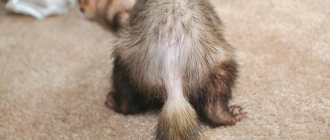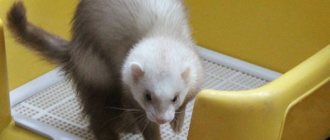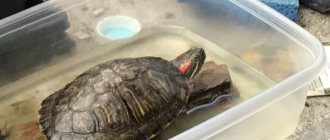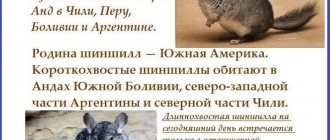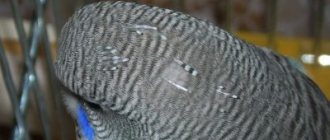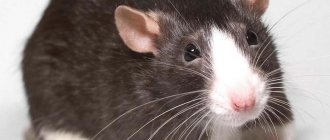Castration and sterilization: what is the difference
Many pet owners equate two completely different concepts: castration and sterilization. These are two different procedures with different consequences.
Castration translated from Latin means “emasculation”, “castration”, that is, a procedure consisting in the removal of reproductive organs through surgery.
During castration, the testes of males are removed, and the ovaries of females are removed. If complete castration is carried out, the female's uterus is also removed. During the operation, the gonads are completely removed, which means that the pets are completely deprived of reproductive function. As a result, ferrets' hormonal levels change.
Sterilization in Latin means “infertility.” During the operation, animals lose the ability to reproduce, but the genitals are preserved and no hormonal disturbances occur.
During the sterilization process, ferrets (males) have their spermatic cords ligated, and female ferrets have their uterus removed.
The two procedures have no effect on the animals' behavior.
Complications that may occur
As is the case with humans, ferrets may not be able to cope with the surgery (although this is rare). As a consequence, the occurrence of postoperative complications.
The reasons are:
- Infection or bleeding. The whole reason lies in: unsterile premises;
- poor handling of instruments for surgery;
- inexperience of the medical worker;
- failure to follow care instructions.
After chem. Sterilization may result in:
- breast disease (proliferation of mammary gland tissue);
- rapid weight gain;
- gastrointestinal diseases, etc.
In order for the results of the operation to be positive, you should carefully choose a veterinarian and follow all the advice of specialists on care and feeding.
Preparing for surgery
Regardless of which ferret surgery technique is chosen, you need to prepare for it in advance. It is important to observe the following:
- About a week before the operation, it is necessary to check his health. If you suspect any illness, you should take him to the vet.
- Stop feeding 8 hours before surgery and stop drinking 2 hours before surgery.
- Carry out wet cleaning in the apartment/room.
- Wash the cage thoroughly and remove the bedding;
- Remove food and water from the cage.
- Prepare a towel or small blanket that will be needed after the operation.
Important: Do not give your pet food or water before surgery.
If the operation is performed in a clinic, after the operation you should wrap your pet in a previously prepared towel or blanket. When transporting an animal home, you need to minimize shaking and other inconveniences.
It is worth noting that a qualified specialist can perform surgery at home.
Ferret sterilization progress
The surgeon’s actions are approximately the same for all breeds of pets.
- The dosage of anesthesia is selected. Anesthesia can be intravenous, intramuscular and inhalational (gas). Inhalation anesthesia is the safest, but requires complex and expensive equipment, which is not available in all clinics. After administering anesthesia, the doctor has an hour to carry out sterilization. After the operation is completed, the animal will sleep for several more hours.
- The ferret is fixed on the operating table in the dorsal position. The doctor shaves the fur on the operated area and treats the skin with antiseptics.
- The genitals are amputated. The doctor makes an incision (usually two) through which the organs are removed.
- The surgeon places sutures that dissolve on their own or must be removed after 7-10 days.
- The owner is given instructions on how to care for the pet after surgery.
The whole action takes about an hour.
Should you neuter your ferret at home?
Veterinarians believe that the castration procedure will be most successful if the ferret is castrated at home. Despite the fact that the service of a doctor visiting your home will cost slightly more than a regular operation in a clinic, castration at home has beneficial advantages:
- You will reduce the stress your pet may experience from the procedure.
- The ferret will be in its usual habitat
- Recovery after surgery will be smoother and painless
If you choose home castration, you need to make sure that the operation will be performed by an experienced specialist who already has experience in similar operations. In addition, the procedure itself must be supported by modern equipment and high-quality anesthetics.
Rehabilitation
After your ferret is castrated, you must strictly adhere to all the recommendations given by the veterinarian. It is prohibited to change or prescribe any medications on your own. Any actions can be carried out only with the permission of the treating specialist.
Most often, sutures are treated with Chlorhexidine and Miramistin. Medicines destroy bacteria on the incision, preventing inflammatory processes. Zelenka and iodine can cause burns, and folk remedies after surgery are very dangerous.
In the first week, you need to carefully observe your pet’s behavior. An increase or decrease in temperature, a change in the color of the mucous membranes are the first signals that something is wrong in the body. It is better to contact the surgeon by phone or immediately take the animal to the clinic.
It is necessary to limit the ferrets’ excessive mobility after surgery and keep them in a cage for the first time.
What to do if your ferret is licking your stitches? If a nimble pet tries to reach the wound through a bandage, it is better to put a special collar on it. You can purchase it at a veterinary pharmacy or make it yourself from a plastic half-liter bottle.
Before the stitches are removed, hygiene procedures and walking outside are prohibited. Until the fur grows back, drafts must be avoided, and any temperature fluctuations must not be allowed: overheating or cooling. After surgery, the permeability of the stomach may worsen, so a one-time intake of 2 g of petroleum jelly will help protect against constipation.
Castration of a male ferret
In the 7th month of life, males begin the rut, which can last from 6 months to a year. At the same time, the ferret will not calm down after one mating, because he will need at least 4 matings with different females. Due to the increase in hormonal levels, problems with the adrenal glands may occur.
To avoid this, it is necessary to perform an operation to remove the testes. However, there is no need to rush into castration too much. The rut marks the final maturation of the animal’s body. Therefore, veterinarians advise castrating before the start of the first rut, but not before the final formation of the testes.
It is easy to notice the beginning of the rut - the pet’s behavior becomes aggressive and anxious, the testicles increase in size, and the skin begins to smell unpleasant. Foul-smelling marks appear in the apartment.
The procedure itself is done in a veterinary clinic, although an experienced doctor can do it at home. The testes are removed from the testicles through small incisions, which will heal quickly and leave no noticeable scars. You can choose general or local anesthesia; castration of the male is a very easy and quick procedure. At the same time, when the ferret is castrated, the anal glands can be removed at the same time.
At the request of the owner, you can only sterilize the ferret, limiting yourself to ligating the spermatic cords. This method will preserve the possibility of mating for the pet, but will make it infertile. However, the unpleasant odor will not go away, so ferrets are spayed infrequently.
The ferret recovers from anesthesia without complications. The sutures are removed already on the 10th day. Care after surgery is the same as for females.
After recovery, the males' character changes. The animal becomes affectionate and friendly, the aggressiveness goes away, and the ferrets stop biting. The marks also disappear. Contrary to popular belief, castration of a ferret does not cause excess weight gain and does not deprive the pet of playfulness and activity.
The undeniable benefits of castration
The ferrets' body is designed in such a way that the male rut lasts about six months a year. The male becomes irritable and aggressive , begins to mark any places indiscriminately, and bites the owners.
His daily routine completely changes: at night he can try to break the cage, during the day he can sleep. There are often cases when males in this state run away from their owners and are even ready to jump out of windows.
You are unlikely to be able to satisfy the needs of a male ferret, because during the rutting season he requires from four to eight different females.
The majority of female ferrets cannot come out of estrus on their own ; in ninety percent of cases, this condition ends in death. Their hormonal balance is completely disrupted: baldness, internal bleeding, exhaustion and other unfavorable processes occur.
Therefore, it is simply necessary to castrate ferrets that are kept at home. Let's look together at the different types of castration of the ferret.
Female ferret in heat
Once started, a ferret's heat will not end without mating. Due to a hormonal imbalance, the animal will begin to lose weight, get sick often, the fur will begin to peel off, and the skin will develop a persistent smell of urine.
Therefore, it is necessary to carefully monitor the onset of puberty in the female. This usually happens at 7-8 months of life, when the first estrus begins. It is important to carry out the operation before it begins, at the age of 5-6 months. The longer you delay spaying a female ferret, the worse it will be for her. The maximum limit is 1-2 donations after maturity.
You can notice the onset of estrus in a ferret by a swollen and enlarged loop and a change in behavior.
How to remove a female from a prolonged heat
A long state of estrus - a month after the start of the rut - leads the pet to exhaustion, baldness, frequent illnesses and even internal hemorrhages. The ferret becomes lethargic and apathetic.
For treatment, you need to carefully study the blood test. And if it is no longer possible to remove the animal’s gonads, temporary measures can be taken:
- Mating with a sterilized male. This will cause ovulation and false pregnancy.
- Injection of the drug "Khorulon". It also leads to a state of false pregnancy. However, it is not recommended to use the product more than once. After such emergency care, it is necessary to sterilize the female with complete removal of the ovaries and uterus.
Sterilization of a female (fert)
There are 3 types of sterilization operations:
- Tubal ligation.
- Ovariectomy - removal of the ovaries.
- Ovariohysterotomy - removal of the ovaries and uterus.
Complete removal of the uterus and gonads is the preferred solution, since it saves the pet from possible complications and from estrus forever. Ferrets tolerate this operation easily. It lasts no more than 20-30 minutes, during which the animal is under general anesthesia.
The incision to remove the gonads is small, about 1.5 cm. The sutures are removed already on the 6-7th day. You can also use special absorbable threads for stitches that do not require removal.
After the procedure, the smell from the ferret's skin will almost completely disappear. In addition, if the paraanal glands are also removed during the operation, the problem of the unpleasant specific smell that ferrets use to mark their territory and scare off enemies can also be solved.
The animal will recover from anesthesia in ~3 hours and will not feel pain or severe discomfort. The technique of the operation is so simple that, if desired, it can be performed even at home. Of course, you need to call a highly qualified doctor for this, and the cost will be higher than in a clinic. But the pet will not experience severe tension and stress.
Chemical sterilization of a female
Some owners do not want to deprive their pets of the joy of motherhood. Then they resort to temporary methods of stopping estrus. However, sometimes the animal may develop an allergy to the chemical components of the drugs.
- Hormonal injections. They cause a state of imaginary (false) pregnancy due to forced ovulation. Estrus passes on the 8th day, but resumes after 4 - 8 weeks, and a new injection is required. This is fraught with complications of the adrenal glands or the appearance of malignant tumors.
- Prolygestone (steroid) injections. They begin to be pricked before the start of the rut. They have many side effects and contraindications and can only be used for completely healthy animals. However, they are good because they are suitable for ferrets of both sexes. They also provoke a state of imaginary (false) pregnancy in females.
- "Suprelorin" is an implant with the substance deslorelin. It is inserted under the skin with a needle. The rut stops after a month, the drug lasts for ~2 years. It does not cause discomfort to the animal and is recognized as the most effective means of chemical sterilization. It costs expensive.
Only a doctor can prescribe and use these drugs. And, of course, these methods will not solve the problem of smell and marks.
Methods
Veterinarians practice two methods of castration:
- chemical;
- surgical.
Let's look at each of them in more detail.
Chemical
This method involves the use of special drugs, including hormonal, steroid and implants. Each of them gives a temporary effect and is fraught with the following consequences:
- Hormonal drugs are intended only for females. They give the effect of an imaginary pregnancy. As a result, estrus stops on the 8th day. After 4-8 weeks it resumes, after which a second injection is required. A significant disadvantage of this method is the development of various tumors.
- Steroid drugs are good because they are suitable for both sexes. The disadvantages include the absence of diseases in the pet at the time of injection and a large number of side effects.
- Implants, the main disadvantage of which is their high cost. Today they are the most effective remedy and have no side effects. The main advantage of the drug is its validity period, 2 years.
Chemical castration does not relieve the animal of the desire to leave marks and the unpleasant smell of fur.
Surgical
Surgery, which is performed under general anesthesia, is the most optimal for the ferret. At the same time, the risks of developing complications are minimal.
The technique of the operation depends on the sex of the animal. Thus, when a male ferret is castrated, the seminal glands are removed. The operation time varies around 10-20 minutes.
In females, surgical intervention in the case of removal of the uterus along with the ovaries takes a little longer.
It is worth noting that, if the owner wishes, a pair of anal glands can be removed from the pet. As a result, after some time, the pet’s fur will acquire a normal smell.
Why spay female ferrets?
Estrus for female ferrets is even more dangerous than rutting for males. In the absence of mating, the animal cannot exit this state on its own, which provokes irreversible physiological disorders, including death. If left untreated, prolonged estrus is characterized by pet lethargy, thinness, and baldness.
The only option is castration. The term “sterilization” for female ferrets is not entirely appropriate, since this is a tubal ligation procedure, and ferrets have their ovaries removed in order to avoid repeat heat. In some cases, the uterus is also removed.
The ideal age for surgery is 6-8 months. In order to maintain the health of ferrets not intended for breeding, it is necessary to neuter both males and females on time.
Preliminary inspection
It is important to make sure that the animal is healthy and will tolerate surgery well. To do this, you need to be examined by a veterinarian a week before surgery.
- To avoid the risks of surgery, you need to carefully choose a clinic. The doctor must have experience treating ferrets - only a professional can correctly calculate the dosage of anesthesia.
- Before surgery, the veterinarian should carefully examine the pet. The doctor is also interested in the ferret’s nutrition, when signs of estrus appeared, and whether there are any specific complaints.
- Blood composition is analyzed. And if the doctor has doubts about the female’s health, they may additionally prescribe a blood biochemistry test. If blood cannot be taken, feces and urine are examined.
Before the operation, it is necessary to undergo an examination by a veterinarian and take blood tests.
The owner must remember that ferret sterilization is only possible for healthy and vaccinated animals. If the heat comes suddenly, and the female has not yet had time to receive all the vaccinations, she will be urgently administered the necessary medications. Further vaccination is discussed with the doctor.
How to care for an animal after castration
After surgery, the ferret is wrapped in a blanket or blanket to provide him with a comfortable environment and help him adapt faster.
Ferrets recover from anesthesia very quickly, but for several hours they cannot control their actions: pets can rise to their paws and immediately fall to the side, shaking their heads. Within a day, the ferret's condition returns to normal.
After the operation, it is recommended to give your pet water, but it is better to wait with feeding until he has fully recovered from the anesthesia. At first, it is recommended to keep the animal in a cage, thereby limiting its mobility.
Sutures are treated with chlorhexidine or another agent prescribed by a veterinarian.
You should not expect a drastic change in behavior from your ferret. The animals become calmer a couple of months after the operation, and over time their temperament gradually evens out.
Feeding your ferret after sterilization
After sterilization, the metabolism changes somewhat, and some processes in the animal’s body slow down.
To maintain a normal balance of proteins, fats and carbohydrates, special food is needed not only for sterilized ferrets, but for all ferrets. Ready-made professional food should be purchased only from premium and super premium manufacturers with an impeccable reputation.
Purchasing economy class food threatens to deteriorate your pet's health, because... Manufacturers of economy-class food introduce food waste, chemicals, dyes, etc. into their composition. Such nutrition will not only not help maintain the health of the pet, but will also cause irreparable damage to the condition of the animal’s body.
Bosh Totally Ferret ferret food is a complete, super premium ferret food. This food contains easily digestible proteins, vitamins and minerals that make your pet's coat smooth, shiny and silky. This food is even used in the diet of ferrets that are preparing to participate in an exhibition.
Postoperative period
After surgery, your ferret needs special care. The owner needs to monitor his condition and limit movement around the house for 2-3 days. He will fully recover from the anesthesia the next day. In the first hours, weakness, loss of orientation, and loss of appetite are observed.
The first feeding after surgery can be done 3-4 hours later. It is recommended to use soft food or dry food soaked in water. Food should be served in small portions.
After surgery, a wound with surgical stitches will remain on the ferret’s body. They need to be treated with antiseptic solutions - peroxide or chlorhexidine. Detailed prescriptions are issued by the attending veterinarian.
Care instructions:
- During the postoperative period, it is forbidden to take the ferret outside for some time. Such walks have a high risk of infection of the animal.
- It is best to leave your pet in a clean cage for the entire rehabilitation period, which will last up to 10 days.
- It is necessary to maintain hygiene in your ferret's cage. Remove any wood filler from the tray and leave a clean grid.
- The ferret does not need to be bathed for 2-3 weeks after surgery.
- For the first two days, the owner needs to monitor the frequency of the animal’s stool. If your pet does not defecate, contact your veterinarian. The doctor will select a drug to eliminate the problem with stool.
10 days after the operation, the sutures are removed.
Life of a ferret after castration
Castration will have a positive effect not only on the ferret’s health, but also on its overall quality of life. The male will again become playful, affectionate, obedient, cheerful, aggression will disappear, the smell of the skin and hormonal levels will normalize, and sexual desire will no longer bother him.
Castration will not affect your ferret's activity or weight in any way. He will continue to be active throughout his life and will remain at his normal weight. Neutered ferrets will not be lazy and put on weight like cats.
In addition, the risk of cancer and adrenal gland diseases in the animal will decrease, and according to statistics, life expectancy will also increase.
Optimal age for surgery
Owners of a male ferret need to know at what age to castrate their pet. After all, if you do this at the wrong time, the animal will begin to have health problems.
The optimal time for the operation is before the start of the first rut. But castration cannot be carried out when the animal has not formed testes in the testicles. Otherwise, this will provoke a delay in the physical and mental development of the animal.
The formation of testes in males occurs at the age of 6-8 months.
Before the start of the first mating season, the pet's behavior changes, its fur will acquire an unpleasant odor, the testes will descend and the testicles will become clearly visible (before that they will be practically invisible).
When the owners do not intend to allow their pet to mate, it is recommended to undergo surgery during this period.
If this is not done, the ferret will become aggressive, start looking for a female, and not finding her, will try to “mate” with the owner’s toys and feet. Due to changes in hormonal levels, the sebaceous glands begin to function incorrectly, the fur becomes greasy, and areas of alopecia appear. The animal's tail and belly are balding.
Living together with a ferret will not be very comfortable, because he will begin to mark his territory and stop going to the litter box. If the pet shits in the wrong place and it was not possible to catch it at the crime scene, then scolding it later is useless; moreover, the animal will be offended and go to the toilet in another revenge.
Read more: Almond tree: how an almond nut grows, what it is, what it looks like
Castration of an animal can be carried out after the end of the rut and even during it. The animal is operated on during the mating season only if it begins to go bald and feels unwell.
But owners must remember that a ferret that has survived one rut remains aggressive even after the pet is castrated.
Relationship between surgical castration and the development of hyperadrenocorticism in ferrets
In an unspayed ferret, luteinizing hormone (LH) from the pituitary gland acts on the testes and ovaries, stimulating the gonads to secrete sex hormones.
After castration, LH continues to be produced in the pituitary gland, but since the gonads are absent, the target tissue becomes the adrenal glands, which contain receptors for LH (after removal of the gonads, the feedback mechanism for suppressing the production of gonadotropin-releasing hormone, which is used to suppress the production of gonadotropin-releasing hormone in a healthy ferret, disappears). production of LH and FSH).
Under the influence of prolonged stimulation, adrenal hyperplasia and neoplasms - adenomas and adenocarcinomas (hyperadrenocorticism) occur. A correlation has been described between the age of castration and the time of manifestation of symptoms of hyperadrenocorticism (the earlier one was castrated, the earlier the disease manifests itself).
The incidence of hyperadrenocorticism in the population of castrated ferrets, according to various authors, is estimated at 20-80%, which is very high.
The main clinical signs of hyperadrenocorticism in ferrets are: spontaneous alopecia (hair loss), itching, enlargement of the skin of the vulva in females, urinary disorders in males (development of prostate cysts). Provided castration is over 7 months of age, the average age of development of hyperadrenocorticism is 3-4 years.
Unfortunately, chemical castration cannot 100% guarantee the absence of the development of hyperadrenocorticism (since this disease has also been described in non-castrated animals), but the likelihood of the disease occurring is several times lower. Photos 5 and 6. Typical appearance of a ferret with hyperadrenocorticism.
Complications of ferret spaying
The more experienced the surgeon, the lower the risk of complications, but they cannot be completely eliminated even with the most qualified doctor.
- Some ferrets are prone to allergies and will have unexpected reactions to anesthesia that cannot be predicted in advance.
- Weight gain. This complication is not caused by sterilization itself, but by a decrease in hormone production. To eliminate the problem, you need to consider a healthy lifestyle for your ferret, reducing the amount of food and increasing the pet’s physical activity.
- Inflammation or suture dehiscence. Usually occurs when the owner does not properly care for the animal. If this complication is detected, you should immediately consult a doctor who will prescribe antibiotics.
- Infection of an animal during sterilization due to insufficient hygiene measures. This only happens to incompetent surgeons, so it is fundamentally important to choose your doctor responsibly.
Complications do not occur in all ferrets; the advantages of sterilization outweigh the possible disadvantages.
Points for and against
Opponents of castration of ferrets are owners who do not have experience in breeding and keeping these animals. The main arguments that are usually put forward against the operation are: inhumane treatment of the animal and deprivation of its ability to reproduce.
As a result, an animal that does not have the opportunity to mate is in constant psychological stress, and a prolonged rut, which causes the production of an increased amount of sex hormones, causes the ferret to become bald and develop many dangerous pathologies.
Often, owners seek medical help too late, and sterilization performed on an adult pet does not help restore the ferret’s lost health.
Veterinarians and experienced breeders advocate the need for castration of ferrets. Removing the gonads, in their opinion, is much more humane than exposing the animal to constant stress and the risk of developing aplastic anemia and other diseases.
pros
The positive aspects of castration of ferrets include the following:
- Males stop leaving unpleasant-smelling marks, and the pungent odor from the pet itself disappears.
- Ferrets stop searching for a sexual partner, become calmer and more obedient, and are easier to train.
- After the intervention, fights and rivalry between individuals of the same sex stop.
- Life expectancy increases, the likelihood of developing certain dangerous pathologies decreases.
Minuses
The disadvantages include possible complications after surgery and side effects of hormonal drugs that are used for chemical sterilization of ferrets.
Benefits of sterilization
- This is the most humane method of dealing with uncontrolled reproduction of animals.
- Sterilization prolongs the life of a pet - statistics show that almost all unsterilized females begin to get seriously ill when they reach childbearing age. This refers to the most dangerous diseases: oncology of the ovaries, uterus, and breast.
- Estrus does not occur - the pet does not leave traces of blood in the apartment, and does not become an object of sexual attention from males.
- Animals become calmer, do not show aggression, and do not bite. After sterilization, pets are more receptive to training.
conclusions
- Chemical castration is the method of choice for suppressing sexual behavior in ferrets; placement of Suprelorin implants is a safe alternative to surgical castration
- Surgical castration is the method of choice if there are medical indications for removal of the uterus, ovaries, testes (neoplasms, inflammation, trauma, etc.)
- Regular placement of Suprelorin implants is recommended for all previously neutered ferrets to prevent hyperadrenocorticism.
